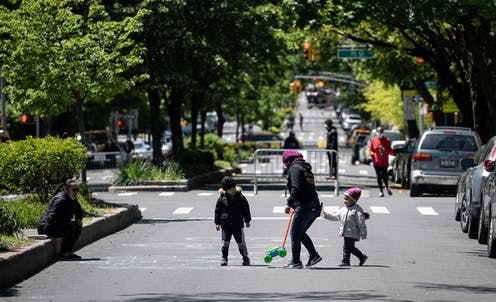
PREV ARTICLE
NEXT ARTICLE
FULL ISSUE
PREV FULL ISSUE
HOW PANDEMICS HAVE CHANGED AMERICAN CITIESLast week we looked at how Philadelphia addressed the yellow fever epidemic in the 1790s. This article discusses the lasting changes disease-fighting efforts brought to cities. -Editor  In 1793, a yellow fever outbreak in Philadelphia killed 5,000 people – about 10% of what was then the U.S. capital's population. At the time Philadelphia, like all American cities, had no municipal garbage services. Hogs roamed streets and ate garbage. On the advice of prominent doctors who redirected blame for the outbreak away from immigrant communities toward sanitizing the city – presciently, since germ theory had not yet been invented – Philadelphia's mayor authorized emergency funding to treat the sick and clean the gutters. Such efforts were a harbinger of urban planning reforms, as cities would take on the costly job of garbage removal and create sanitation departments over the next 50 years. These measures greatly improved residents' health in the short and long term. They also added alleyways to cities, for garbage removal. When contaminated water brought waves of cholera sweeping through the U.S. in the 1850s, cities across the country birthed the twin agencies of public health and urban planning to make and enforce regulations. In the same period, New York City's Board of Health made way for Central Park – the nation's first public park – on the premise that open urban space improved human and environmental health. The park housed a reservoir designed to deliver fresh, clean water to the burgeoning city. It received water from one of the nation's first great aqueducts. For the first time New York's housing development was planned, with growth attached to funding for sewer and water lines. By 1916, this patchwork of development directives was compiled into the U.S.‘s first citywide zoning code. Cities everywhere followed New York's example, taking control of land use and vanquishing waterborne pathogens like cholera and polio by the mid-1900s. Thankfully the days of open sewers and horse droppings are behind us now. But what's next? -Editor Common-sense steps cities can take to fight the coronavirus are emerging. One promising pilot involves closing some streets to cars, as Oakland and New York, among others, have done. This allows city dwellers to get outside and walk – but not too close together – as recommended for maintaining physical and mental health. Such pilot closures may eventually "unpave the way," creating urban greenbelts for walking and biking at a safe distance in even the densest of places. ... American cities have triumphed over infectious diseases many times before. I'm hopeful we can do it again. To read the complete article, see:
To read the earlier E-Sylum article, see:
 Wayne Homren, Editor The Numismatic Bibliomania Society is a non-profit organization promoting numismatic literature. See our web site at coinbooks.org. To submit items for publication in The E-Sylum, write to the Editor at this address: whomren@gmail.com To subscribe go to: https://my.binhost.com/lists/listinfo/esylum All Rights Reserved. NBS Home Page Contact the NBS webmaster 
|